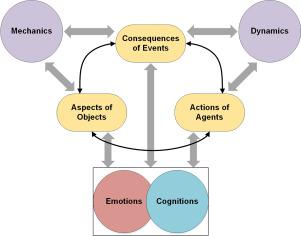Unveiling the Psychology Behind Gamification in Education: How Game Elements Boost Student engagement
In today’s fast-evolving educational landscape, engaging students is more challenging than ever.Traditional teaching methods often fall short in capturing learners’ attention and retaining their interest. Enter gamification in education—a dynamic approach that integrates game elements into the learning process to make it more interactive, enjoyable, and effective. But what drives this approach, and why does it work so well? In this article, we’ll unveil the fascinating psychology behind gamification in education and demonstrate how game elements can supercharge student engagement and achievement.
The Science of Gamification: Psychology Meets Education
Gamification utilizes mechanics present in video games—such as points, badges, leaderboards, and challenges—to transform the way students learn. But its effectiveness isn’t accidental; it’s rooted in psychological principles of motivation and behavior. Let’s break down the core psychological concepts that power gamified learning:
- Intrinsic Motivation: Gamification taps into intrinsic motivators such as curiosity, mastery, and autonomy. When learners feel they are progressing, mastering new skills, or have control over their choices, their engagement soars.
- Immediate Feedback: Games offer instant feedback, helping students adjust strategies and learn from mistakes without the discouragement associated with failure.
- Goal Setting and Achievement: Clear goals, challenges, and rewards stimulate the brain’s reward circuitry, promoting persistence and satisfaction.
- Social Elements: Leaderboards and collaborative missions foster healthy competition and a sense of community, both powerful engagement drivers.
- Progress Mechanics: Visible progress bars or badge systems keep learners motivated by showing tangible evidence of improvement.
Key Game Elements That Boost Student Engagement
Effective gamification in education relies on incorporating carefully chosen game mechanics that align with learning objectives. Here are the most influential game elements—and how they impact student engagement:
Points and Reward Systems
- Points create a measurable sense of progress and accomplishment.
- Reward systems can be aligned with educational milestones, reinforcing positive behaviors.
Badges and Certificates
- Badges symbolize achievements, motivating students to strive for recognition.
- Certificates provide extrinsic motivation and can be shared with peers or family.
Leaderboards and Social Comparison
- Public rankings inspire healthy competition and push students to improve.
- Collaboration features foster teamwork and collective problem-solving.
Levels and Progress Bars
- Levels break down content into manageable chunks, reducing overwhelm.
- progress bars offer visual feedback, increasing persistence and motivation.
Challenges and Quests
- Challenges spark curiosity and encourage exploration of new topics.
- Quests add context and narrative, making learning memorable and engaging.
Benefits of Gamification in Education
Integrating game elements in the classroom yields many positive outcomes.Here are some of the most powerful benefits supported by recent studies and first-hand experiences:
- Increased Engagement: Gamification transforms passive learners into active participants, capturing their attention and sustaining interest.
- Enhanced Motivation: the drive to earn points, unlock levels, or top leaderboards fosters intrinsic and extrinsic motivation.
- Faster Feedback and improved Learning: Instant feedback allows students to correct mistakes in real-time, promoting deeper understanding and retention.
- Stronger Collaboration: Group quests or team challenges promote interaction, leadership, and social skills.
- Personalized Learning Journeys: Adaptive challenges and rewards can be tailored to individual strengths, learning paces, and interests.
Case Studies: Gamification in Action
Kahoot! Revolutionizes Classroom Quizzes
One remarkable example is Kahoot!, a game-based learning platform that turns quizzes into competitive, high-energy activities. Teachers observe increased participation rates,improved learning outcomes,and a noticeable boost in classroom morale.
Duolingo Makes Language Learning Addictive
Duolingo employs progress bars, streaks, and reward systems to keep millions of users motivated in their language learning journey. The addictive nature of its gamified approach results in higher course completion rates compared to traditional language programs.
Classcraft: RPG for Social and Emotional Learning
Classcraft integrates RPG-style elements (avatars, quests, experience points) to promote not only academic achievement but also teamwork, empathy, and positive behavior. teachers report fewer disciplinary issues and a stronger classroom community.
Practical Tips for Implementing Gamification in Education
Ready to introduce game elements in your classroom? Here are practical strategies to ensure accomplished gamification:
- Align game mechanics with learning objectives. Don’t gamify for gamification’s sake; make sure each element reinforces educational goals.
- Start small. Introduce quizzes, badges, or leaderboards for specific topics before scaling up.
- Solicit student feedback. Let learners share which elements they find most motivating.
- Maintain balance. Ensure collaboration doesn’t morph into unhealthy competition.Celebrate effort as much as achievement.
- Use technology wisely. Leverage gamified platforms (like Kahoot!, Classcraft, or Duolingo) or create your own using digital tools and WordPress plugins.
First-Hand Experience: Educator and Student Perspectives
“After integrating a badge system into my history classes, I saw students going above and beyond—researching topics independently and helping peers, just to earn the coveted ‘Research Master’ badge. It was unbelievable to witness their change from passive listeners to enthusiastic learners.”
– Sarah, High school Teacher
“With gamified quizzes, studying no longer feels like a chore. Competing with my friends for the top spot and collecting badges turns learning into a fun challenge.”
– Alex, Grade 8 Student
Conclusion: Gamification Is shaping the Future of Education
The psychology behind gamification in education reveals that when students are motivated, challenged, and immersed, they don’t just participate—they thrive. By harnessing the powerful elements of play, educators can boost engagement, deepen learning, and create more inclusive, impactful classrooms.
As technology evolves and our understanding of educational psychology deepens,gamification will continue to transform teaching and learning. Ready to unlock student potential? Start gamifying your lessons and unveil a new world of possibilities in education.

